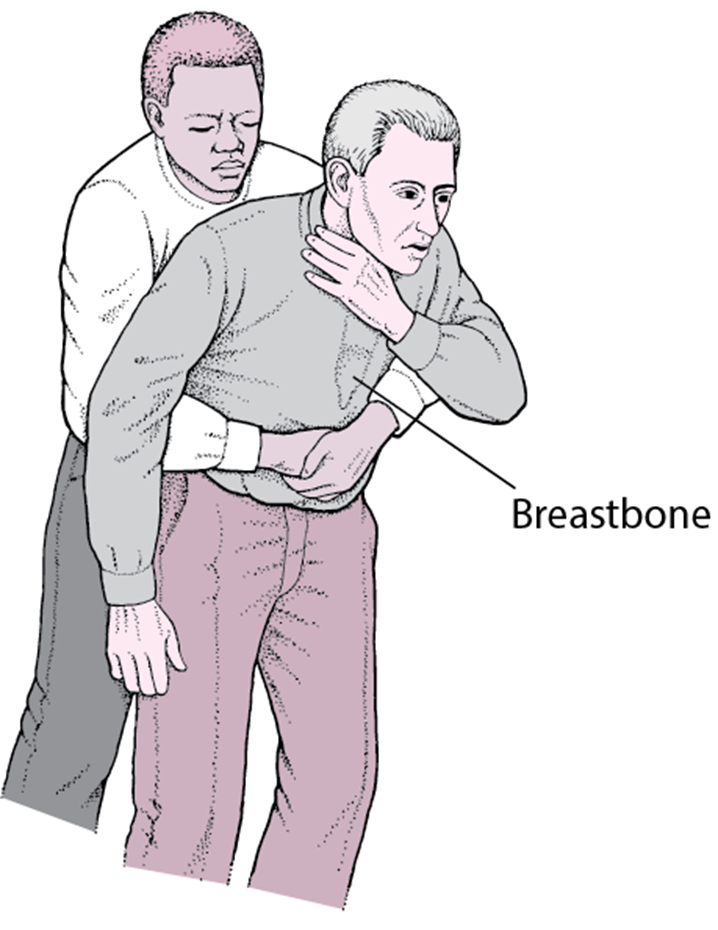A nurse is dining at a restaurant when a woman begins to scream that her partner is choking. Which of the following actions should the nurse take?
Instruct the woman to call 911.
Use the abdominal-thrust maneuver.
Ask the partner if he can speak.
Perform chest compressions.
The Correct Answer is B
A. Instruct the woman to call 911: This is a correct action, but it should be the second step after the nurse initiates first aid measures. Directing someone to call for emergency assistance is crucial, but immediate intervention to relieve the choking takes precedence.
B. The Heimlich maneuver involves abdominal thrusts and is the recommended technique for relieving choking in a conscious person. It is essential to act quickly and decisively to clear the airway.
C. Ask the partner if he can speak: If the person is unable to speak, cough, or breathe, it may indicate complete airway obstruction. The nurse should not delay intervention by asking if the person can speak but should immediately proceed with measures to relieve the choking.
D. Perform chest compressions: Chest compressions are not indicated for a conscious choking victim. Chest compressions are performed in the context of cardiopulmonary resuscitation (CPR) for an unconscious person with no pulse.

Nursing Test Bank
Naxlex Comprehensive Predictor Exams
Related Questions
Correct Answer is A
Explanation
A. Cheyne-Stokes respirations: Cheyne-Stokes respirations are characterized by alternating periods of hyperventilation followed by apnea. This respiratory pattern is often observed in clients with conditions affecting the central nervous system, such as brain injury or stroke.
B. Apneustic respirations: Apneustic respirations are characterized by prolonged, gasping inhalations followed by extremely short, ineffective exhalations. This pattern is associated with damage to the pons, a part of the brainstem.
C. Stridor: Stridor is a high-pitched, noisy breathing sound caused by turbulent airflow through a partially obstructed airway. It is not related to the described alternating pattern of hyperventilation and apnea.
D. Kussmaul respirations: Kussmaul respirations are deep, rapid respirations often seen in metabolic acidosis. They are not characterized by the alternating pattern described in the scenario.

Correct Answer is C
Explanation
A. High-density lipoprotein (HDL) level of 70 mg/dL: Having a high HDL level is generally considered a protective factor against cardiovascular disease, including hypertension.
B. A diet high in potassium: A diet high in potassium is often associated with a lower risk of hypertension. Potassium helps balance sodium levels and supports healthy blood pressure.
C. Obstructive sleep apnea (OSA): This is the correct answer. Obstructive sleep apnea is a known risk factor for hypertension. The repeated episodes of interrupted breathing during sleep can contribute to increased blood pressure.
D. Taking benazepril: Benazepril is an angiotensin-converting enzyme (ACE) inhibitor commonly used to treat hypertension. While it is used to manage high blood pressure, taking the medication itself is not a risk factor for developing hypertension.
Whether you are a student looking to ace your exams or a practicing nurse seeking to enhance your expertise , our nursing education contents will empower you with the confidence and competence to make a difference in the lives of patients and become a respected leader in the healthcare field.
Visit Naxlex, invest in your future and unlock endless possibilities with our unparalleled nursing education contents today
Report Wrong Answer on the Current Question
Do you disagree with the answer? If yes, what is your expected answer? Explain.
Kindly be descriptive with the issue you are facing.
